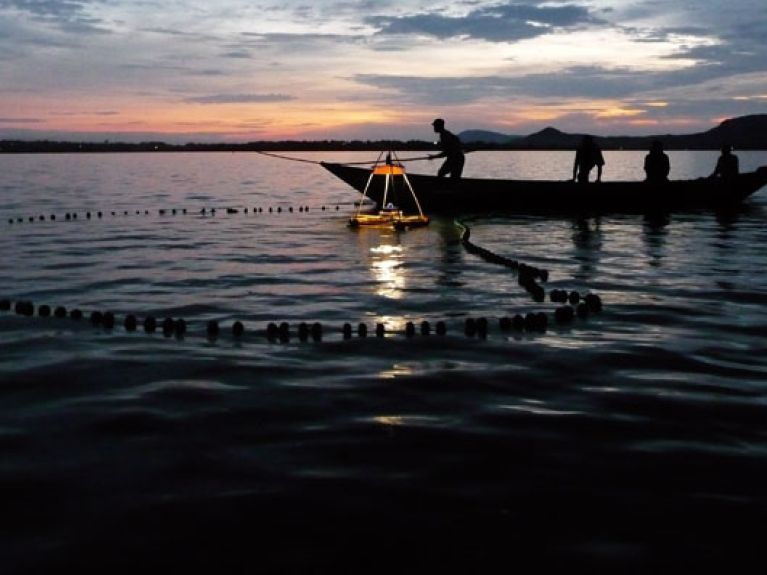Light and shadow at Lake Victoria
German lighting manufacturer Osram brings environmentally friendly and inexpensive light to Kenya’s fishing villages.

When night falls at Lake Victoria, the working day starts in earnest for the fishermen of Mbita. The men repair their nets on the beach and load up their long wooden boats with provisions. The last thing to go on board is the most important of all – a kerosene lamp mounted on a small wooden raft. Once the fisherman have reached their fishing grounds far out on the lake they lower the lamp onto the water. The light attracts the insects, and the insects attract the fish.
This simple technique has worked well for generations in Kenya, but Oscar Ominde wants things to change. As the first lamps start to twinkle out on the horizon, Ominde approaches a boat owner who has not quite completed his preparations: “Can you really afford to burn up cash night after night?” The fisherman looks up in surprise; Ominde has him hooked. “I’m from Osram, a company in Germany,” he says. “And I’d like to help you save a lot of money.”
Though Ominde has worked on the banks of Lake Victoria for years, there are many people who have still not heard his message: every night, around 175,000 fishermen take their boats out onto the lake. With their kerosene lamps on board, however, the damage is three-fold: they damage the environment, their own health – and their wallets. Kerosene regularly leaks into the water, and the lamps also emit a large amount of carbon dioxide. The smoke can cause breathing problems. And the fishermen are reminded every day that the fuel itself is pretty expensive. The German lighting manufacturer Osram, where Ominde works, has designed an alternative for the men in Mbita: a bright energy-saving lamp which, together with its rechargeable battery, is small enough to fit onto the floating wooden platforms. It doesn’t flicker, it doesn’t produce any soot, and its price is low: recharging the battery for one night of use costs the equivalent of around one euro. The kerosene costs the fishermen 1.50 euros.
Like in many parts of Africa, electric light cannot be taken for granted in the Lake Victoria region, and millions of people here live without power. In most communities there is no grid infrastructure at all. To offer environmentally friendly light in these areas, Osram has installed decentralized electric charging stations right in the middle of the villages. The company calls the small green-and-white painted buildings “WE hubs” – W standing for water and E for energy. To illustrate how the system works, Ominde climbs up onto the roof, where 72 solar modules are installed. The energy they produce is used inside the shed. Dozens of rechargeable batteries – blue boxes roughly the size of a car battery – are stacked inside on a shelf, where they are in the process of being charged. When a customer arrives with an empty battery, it can be exchanged immediately for a full one. At the same time, a small filter system purifies rainwater to make drinking water that customers can purchase at the WE hub in an attempt to establish the hub as a firm fixture of village life.
This was anything but easy in the early days. When Osram opened its first energy hub in Mbita in 2008, the locals showed virtually no interest in it. In the first six months there was not a single paying customer. “It’s natural that we encountered a certain amount of basis scepticism,” says Ominde. After all, it’s not easy to convince people that a new system is better if the old one always worked perfectly well in the past. “Many of the problems were also down to us, however.”
Initially, for example, the people who worked for Osram did not know which fishermen to approach in order to advertise their products, and generally ended up talking to employees rather than the owners of the boats who actually make decisions about what to purchase. What is more, the set-up was not really all that convenient for the fishermen: whereas kerosene could be bought directly down on the beach, the energy hub was a long way away. Ominde responded by arranging a mobile solution: every day, he had a cart full of charged batteries pulled down to the beach by donkey. Although the project appeared to make a lot of sense on the drawing board, a great deal of fine-tuning was needed to make it work in reality.
Another thing that the company needed to do was change the battery technology, because the old batteries gave up the ghost too quickly. The batteries were also given additional functionality, such as a USB port that can be used to recharge a mobile phone. Every hub also boasts a small Internet café, which raises its profile in local village life. To date, three hubs with a total of 1,500 regular customers are now in service, and five new hubs are to be set up in 2014. To drive forward the expanding project, Osram is no longer solely responsible and has arranged for partners like Siemens Stiftung and the Global Nature Fund to come on board. What is more, everyday business operations are now in Kenyan hands: local social enterprise Light for Life is responsible for running the hubs, with the support of Osram employee Ominde.
Late evenings these days, all he sees of the fishermen out on the lake are tiny dots of light on the horizon, hundreds of them visible on clear nights. Ominde can even tell from the way the light flickers whether it’s a kerosene lamp or one of his electric ones. Like every night, the kerosene customers are still in the majority, so Ominde and his colleagues have plenty of work to do to persuade them to make the switch. ▪
Mathias Peer

